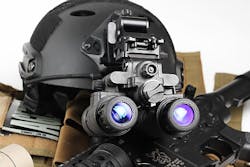Navy picks Creative Microsystems to design next-generation night-vision technology
WASHINGTON, 22 May 2014. U.S. Navy researchers are moving forward with a program to shrink the size and increase the capabilities of the next-generation military night-vision goggles, while drastically reducing the cost of manufacturing these night-vision devices.
Officials of the Naval Research Laboratory (NRL) in Washington announced a plan Monday to award a sole-source research contract to Creative Microsystems Corp. (CMC) in Waitsfield, Vt., for the Micro Optic Low Light Imager (MOLLI) project to design next-generation lightweight high-performance military night-vision goggles.
CMC electro-optics experts will measure the size and performance of their new night-vision goggles design against the current-generation AN/PVS-31 night-vision binocular. The new design at first should weigh no more than 17.65 ounces, and ultimately should weigh no more than seven ounces and as little as 3.5 ounces, Navy researchers say. The AN/PVS-31, by contrast, weighs nearly 21 ounces.
The new design will be a low-light-amplification system with a spectral response in the visible, near infrared (NIR), and shortwave infrared (SWIR) light bands. Navy officials want the new night-vision goggles design within five years, with a plan that ultimately would cost 75 to 90 percent less than current models to manufacture in high volumes.
Related: Army picks DRS and BAE Systems to develop integrated night-vision goggles and weapon sights
CMC experts are being asked to design an imaging array that gives the new binocular night-vision goggles design a wide field of view. Company engineers will develop an application-specific integrated circuit (ASIC) that supports a hybrid-electro-optic imaging approach.
The hybrid design will combine scene elements from the imaging array and amplifier pair into one high-resolution image. High-performance optics will produce a reduced form factor emissive near-to-eye display that provides the viewer with 20/20 acuity, Navy researchers say.
The estimated value of the two-year contract is $2.7 million. CMC holds the proprietary intellectual property necessary to design the kind of night-vision goggles the Navy wants, officials say, and is the only qualified source able to do the work at an affordable cost.
Related: DRS to develop enabling technologies for special-ops multispectral night-vision goggles
More information on the MOLLI project is online at https://www.fbo.gov/spg/DON/ONR/N00173/N00173-14-C-2010/listing.html.
For additional information contact Creative Microsystems Corp. online at www.creativemicro.com, or the Naval Research Laboratory at www.nrl.navy.mil.

